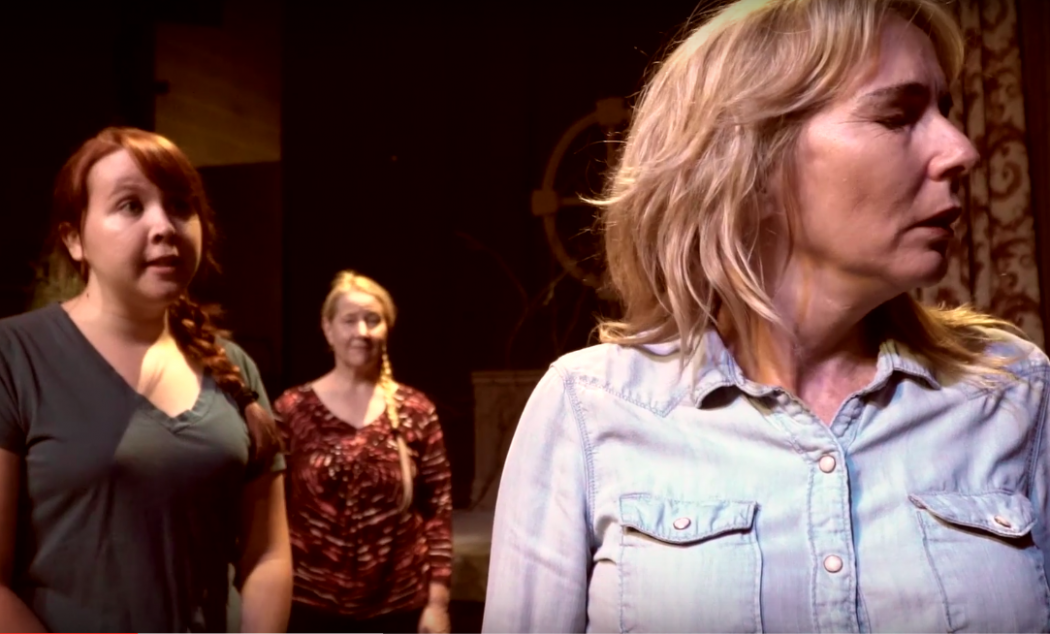“A friend of mine was like, ‘It’s going to be set in a theater. About actors. And it’s a oner. You’re kind of doing Birdman there.'”
Every year, LakeFrontRow talks to the filmmakers behind some of our favorite entries from Madison’s 48 Hour Film Project, which challenges teams to write, shoot and cut a short film in the span of one weekend.
Philip Birdener’s Time Guide grants Olivia Castleton (Donna Kummer) a fleeting glimpse back at her days as a struggling ingénue (Jordyn Stewart). While Olivia watches her younger self learn patience and humility, “Good Land Media” and David Kaye assemble a bravura “long take” and the most ambitious entry out of any of this year’s 48 Hour Film Projects. A Measure of Time makes plain its team’s passion for performance with an uproarious mock play, deep staging, and (intentional or not) an incredibly faithful sound mix that plumbs the depths of a ragtag troupe’s dress rehearsal.
Credited director David Kaye is in the midst of casting a play at the Waukesha Civic Theater, so I reached out to co-director and cinematographer Trever Siegman to discuss, among other things, the insanity of doing a long take for the 48:
I want to dive right into the long take, because it really emphasizes the “time” element at play. What motivated you to choose that?
This is my fifth 48 Hour Film Project, and I like to challenge myself with every one. This year, I simply wanted to do a “oner,” whether a true oner or in multiple takes to emulate one. And I knew that going in.
I didn’t want to mimic Birdman, though. A friend of mine was like, “It’s going to be set in a theater. About actors. And it’s a oner. You’re kind of doing Birdman there.”
You mention multiple takes. What were the logistics behind the camera?
David did a run-through with the actors and some blocking on-stage. Then we did two takes of a full-out oner and it kind of sucked [laughs]. For every mistake and every stutter, we had to start over. I finally said “Okay, where can we splice in an edit and still have the story continue?”
It’s not all in one take. We ended up having four edit points. The first is from the start of the movie to when we first go backstage. And that’s a good chunk. That’s about two or three minutes. The whole backstage is another cut. Then the camera dollies back and follows older Olivia to the stage. Then from walking onstage until the end, that’s another take.
There’s one edit that I’m kind of disappointed in. It’s a sore thumb. When we come back around to the stage manager, you can see a dissolve.
Overall, would you say you were satisfied with how the effect turned out?
It was tiresome because the actors had to hit their marks and big chunks of their lines, but they only had an hour or so to memorize a six-page script. My biggest concern was making sure the actors were happy with the idea that if they made a mistake, we were going to have to start at the beginning again. That was the big thing, making sure everyone was happy.
You drew time travel as your genre, so where did the idea of telling a story about the theater come from?
We got the core crew together at the table read and threw around ideas that suited the location. David, being the lead writer, wanted to tell a story about acting. That acting is a hard job and there’s a lot of regret and “what ifs” but one person can’t hold you down. He wanted to tell a story where, if you could go back, what would you change?
And who wrote the anti-Protestant play they’re performing?
David, [assistant director] Nicole Langenfeld and [camera assistant] Richard Wilkerson all wanted to know what the dialogue was early on but David went and just wrote it. That fits into his realm, too. He’s so comfortable that he can easily put together a dramatic scene like that. It’s also funny, because David’s making actors talk like they’re in Downton Abbey. There’s a message in it but it’s making fun of actors in real life. He wanted to have fun with it.
If this were the 72 Hour Film Project, what would you have done differently?
If you have great audio and a bad story, people are still tuned to it. Audio is key. It’s probably what every group has a problem with every year. I would touch up the audio. Not to spoil anything, but I can hear things that we’re not supposed to hear in the final mix, but I’m really happy with what we accomplished.
- 2016’s audience favorites, as well as a handful of judges awards, will be announced at the Madison 48 Hour Film Project’s “Best Of” Screening. The screening takes place at 5:00p at the High Noon Saloon on Sat, Aug 27. Admission is $5.

